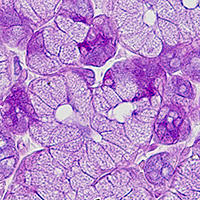Morphological and histochemical characterization of the secretory epithelium in the canine lacrimal gland

Accepted: 14 October 2021
HTML: 19
All claims expressed in this article are solely those of the authors and do not necessarily represent those of their affiliated organizations, or those of the publisher, the editors and the reviewers. Any product that may be evaluated in this article or claim that may be made by its manufacturer is not guaranteed or endorsed by the publisher.
Authors
In the present study, the expression of secretory components and vesicular transport proteins in the canine lacrimal gland was examined and morphometric analysis was performed. The secretory epithelium consists of two types of secretory cells with different morphological features. The secretory cells constituting acinar units (type A cells) exhibited higher levels of glycoconjugates, including β-GlcNAc, than the other cell type constituting tubular units (type T cells). Immunoblot analysis revealed that antimicrobial proteins, such as lysozyme, lactoferrin and lactoperoxidase, Rab proteins (Rab3d, Rab27a and Rab27b) and soluble N-ethylmaleimide-sensitive fusion protein attachment protein receptor (SNARE) proteins (VAMP2, VAMP4, VAMP8, syntaxin-1, syntaxin-4 and syntaxin-6), were expressed at various levels. We immunohistochemically demonstrated that the expression patterns of lysozyme, lactoferrin, Raba27a, Rab27b, VAMP4, VAMP8 and syntaxin-6 differed depending on the secretory cell type. Additionally, in type T cells, VAMP4 was confined to a subpopulation of secretory granules, while VAMP8 was detected in almost all of them. The present study displayed the morphological and histochemical characteristics of the secretory epithelium in the canine lacrimal gland. These findings will help elucidate the species-specific properties of this gland.
How to Cite

This work is licensed under a Creative Commons Attribution-NonCommercial 4.0 International License.
PAGEPress has chosen to apply the Creative Commons Attribution NonCommercial 4.0 International License (CC BY-NC 4.0) to all manuscripts to be published.
Similar Articles
- Tadashi Yasui, Hiroshi Gomi, Taishi Kitahara, Azuma Tsukise, Ultrastructure and immunohistochemical characterization of proteins concerned with the secretory machinery in goat ceruminous glands , European Journal of Histochemistry: Vol. 61 No. 3 (2017)
You may also start an advanced similarity search for this article.

 https://doi.org/10.4081/ejh.2021.3320
https://doi.org/10.4081/ejh.2021.3320






